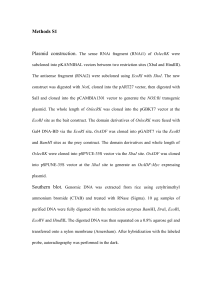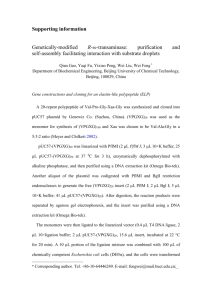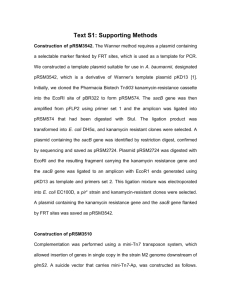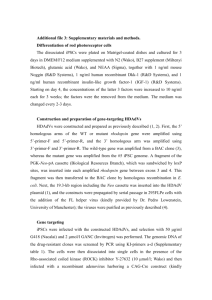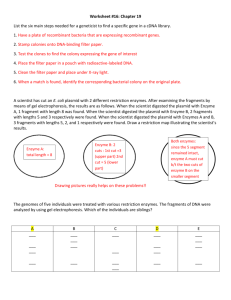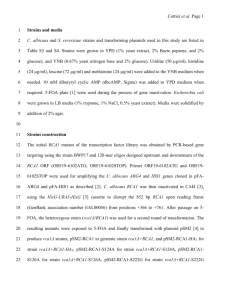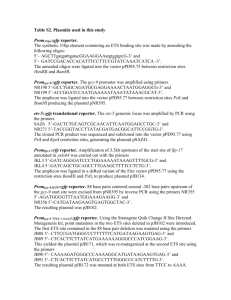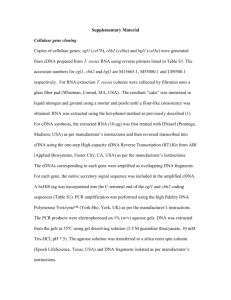bit25886-sup-0002-SuppData-S1
advertisement
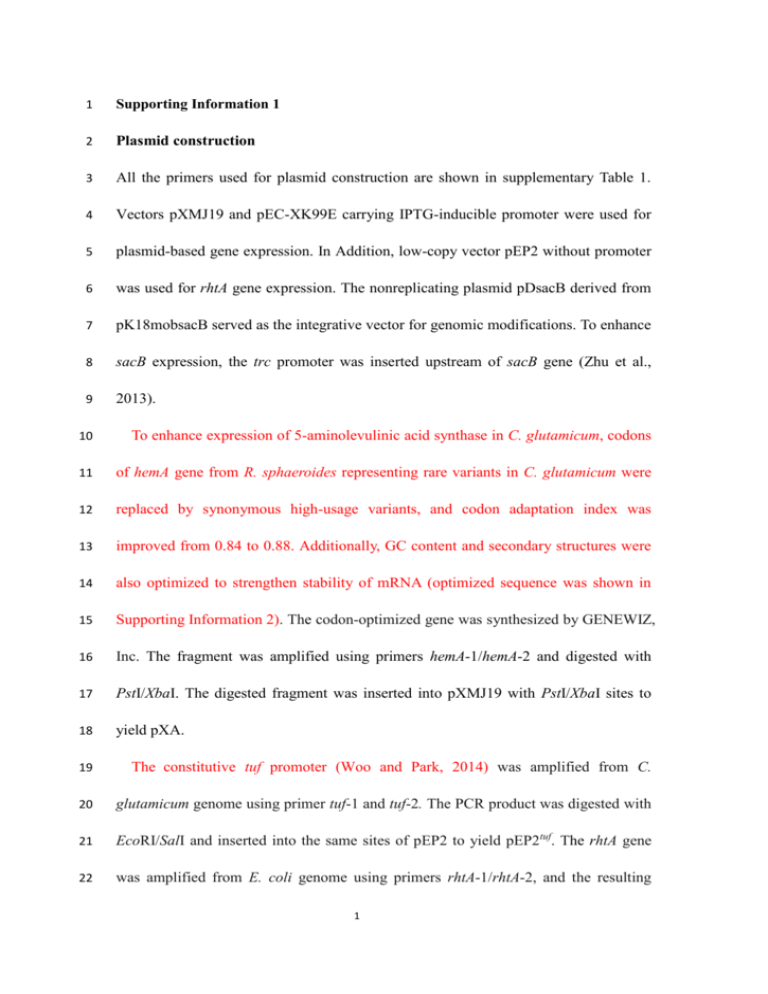
1 Supporting Information 1 2 Plasmid construction 3 All the primers used for plasmid construction are shown in supplementary Table 1. 4 Vectors pXMJ19 and pEC-XK99E carrying IPTG-inducible promoter were used for 5 plasmid-based gene expression. In Addition, low-copy vector pEP2 without promoter 6 was used for rhtA gene expression. The nonreplicating plasmid pDsacB derived from 7 pK18mobsacB served as the integrative vector for genomic modifications. To enhance 8 sacB expression, the trc promoter was inserted upstream of sacB gene (Zhu et al., 9 2013). 10 To enhance expression of 5-aminolevulinic acid synthase in C. glutamicum, codons 11 of hemA gene from R. sphaeroides representing rare variants in C. glutamicum were 12 replaced by synonymous high-usage variants, and codon adaptation index was 13 improved from 0.84 to 0.88. Additionally, GC content and secondary structures were 14 also optimized to strengthen stability of mRNA (optimized sequence was shown in 15 Supporting Information 2). The codon-optimized gene was synthesized by GENEWIZ, 16 Inc. The fragment was amplified using primers hemA-1/hemA-2 and digested with 17 PstI/XbaI. The digested fragment was inserted into pXMJ19 with PstI/XbaI sites to 18 yield pXA. 19 The constitutive tuf promoter (Woo and Park, 2014) was amplified from C. 20 glutamicum genome using primer tuf-1 and tuf-2. The PCR product was digested with 21 EcoRI/SalI and inserted into the same sites of pEP2 to yield pEP2tuf. The rhtA gene 22 was amplified from E. coli genome using primers rhtA-1/rhtA-2, and the resulting 1 23 PCR product was digested with XbaI/BamHI and inserted into XbaI/BamHI sites of 24 pEP2tuf to give plasmid pEP2-rhtA. 25 For pD-pck construction, upstream and downstream fragments of pck gene were 26 amplified from C. glutamicum genome using primers pck-1/pck-2 and pck-3/pck-4, 27 the upstream fragment was digested with EcoRI/XbaI and ligated into pD-sacB 28 digested with the same enzymes to yield pD-pck (F). The obtained plasmid was 29 digested with PstI/HindIII and ligated with downstream fragment digested with the 30 same restriction enzymes to yield pD-pck. 31 To knock out pbp1a, the upstream and downstream fragments of the target gene 32 were amplified from C. glutamicum genome using pbp1a-1/pbp1a-2 and 33 pbp1a-3/pbp1a-4. The two fragments were fused and amplified with pbp1a-1/ 34 pbp1a-4. The fused fragment was then digested with BamHI/HindIII and inserted into 35 the same sites to create pD-pbp1a. pD-pbp1b, pD-pbp2a and pD-pbp2b were obtained 36 by the same procedure using corresponding primers and restriction enzymes. 37 Strain construction 38 All strains in this study are listed in Table 1. Chromosomal inactivation of pck, pbp1a, 39 pbp1b, pbp2a and pbp2b were performed via two-step homologous recombination 40 using corresponding plasmids. The plasmids were transformed into C. glutamicum 41 using electroporation, and the procedure in detail was achieved as described 42 previously (Chen et al., 2015). 43 Plasmid stability during fermentation 44 To investigate the stability of pXA and pEP2-rhtA in C. glutamicum ALA7, we 2 45 examined the percentage of chloramphenicol and kanamycin resistant cells at the end 46 of cultivation. The culture was diluted and plated onto a nonselective BHI agar plate 47 and a selective agar plate (containing 25 μg/mL kanamycin and 10 μg/mL 48 chloroamphenicol). Following incubation for 48 h at 30 ℃ , the number of 49 plasmid-carrying cells was calculated by comparing the number of colonies on a 50 selective agar plate and nonselective agar plate. 3
